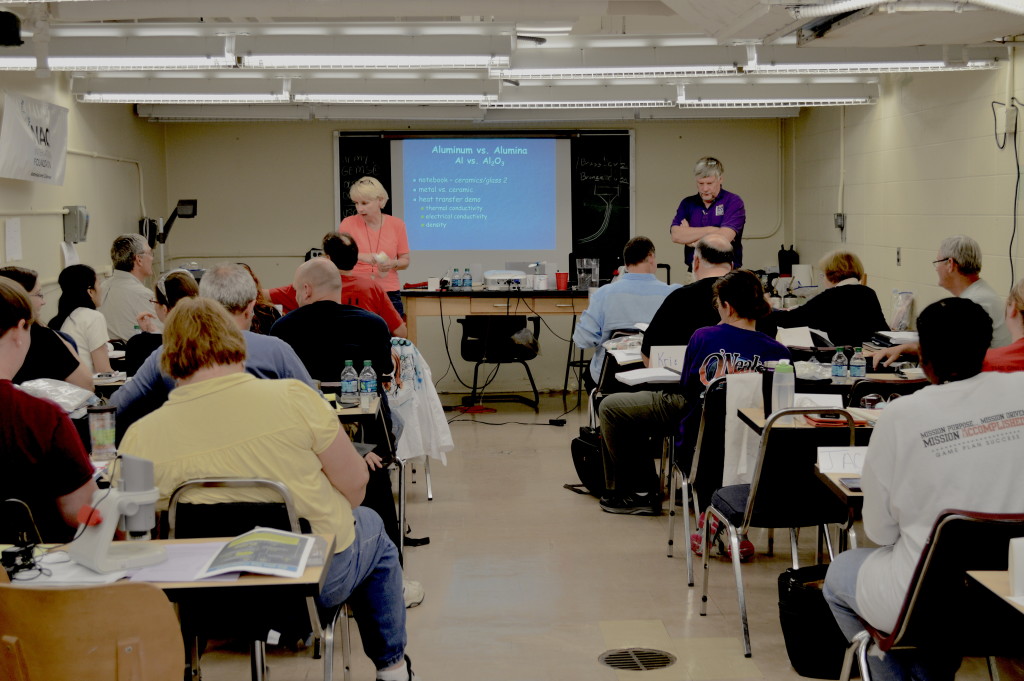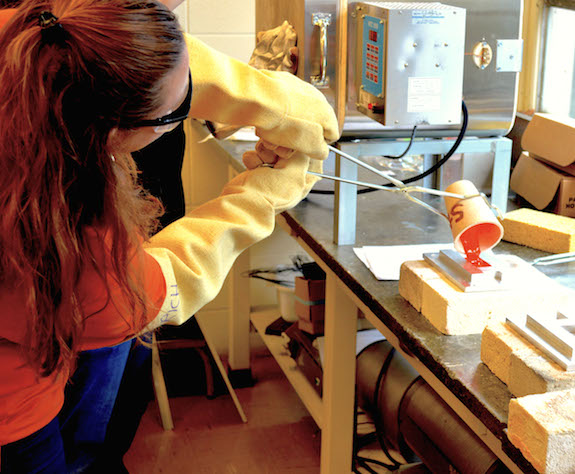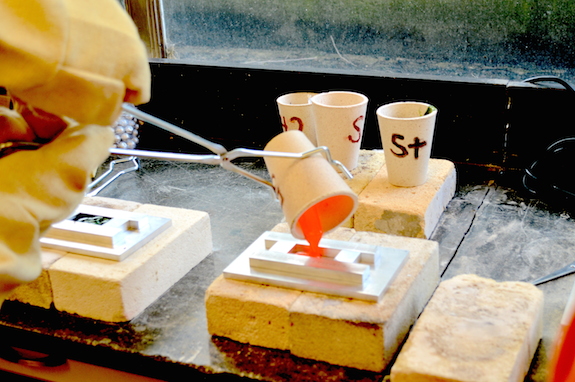
[Image above] Science teachers gather in the lab to demo potential classroom experiments at ASM Materials Education Foundation Materials Camp for Teachers. Credit: ACerS
The need for pros in the fields of science, technology, engineering, and mathematics—also known as STEM professionals—has never been greater. In fact, one million more will be needed in the U.S. alone by 2022, according to the 2012 President’s Council of Advisors on Science and Technology Report on Education.
And the situation gets serious when it comes to recruiting the next generation of materials scientists—specifically in the areas of ceramics and glass engineering. It’s imperative to nearly every industry focused on innovative clean energy solutions to be able to use ceramics and glass to create stronger, lighter, and more durable products.
So what can we do to inspire growth in this field?
The key is to engage students early in their academic careers and get them excited about materials science. Because today’s students will be tomorrow’s innovators.
And there is no group more passionate about inspiring the next generation of scientists and engineers than science teachers, as I got to learn first-hand as a guest at the Materials Camp for Teachers, organized by the ASM Materials Education Foundation, held June 15-19 at Ohio State University’s main campus.
The camp brings together high school and junior high science teachers from around the country and abroad to trade ideas about how to engage students in the science lab. This year’s camp focused on solids, metals, corrosion, ceramics/glass, polymer, and composites, and included labs, demos, and lectures to help teachers prepare for and implement successful materials science courses at their schools.
The Ceramic and Glass Industry Foundation—a global partnership among organizations devoted to science, engineering, and technology of ceramics and glasses—was one of this year’s event sponsors. Marcus Fish, CGIF development director, spent some time talking with the teachers during lunch at the event on Thursday, June 19.

Marcus Fish, CGIF development director, presents information about the PCSA Materials Science Kits to teachers during lunch at the ASM Materials Camp on June 18. Credit: ACerS
“So many companies are competing for graduates with degrees in the ceramics and glass engineering fields. The demand for skilled individuals in this area is huge—especially as green energy initiatives continue to only get bigger worldwide and are heavily reliant on the use of composites,” Fish said during a brief presentation about CGIF.
Fish talked about CGIF’s mission: to help educate and create opportunities for the next generation. One initiative in the works is the creation of a career database that will help pair students with internships and jobs in the ceramics and glass field.
CGIF also donated ACerS’ President’s Council of Student Advisors’ (PCSA) Materials Science Kits to the teachers at the camp so they can test out the experiments with their students back in the classroom.
Talk of the kits prompted stories from some of the teachers who have used them about their favorite experiments. One of the clear fan favorites is the candy fiber pull experiment—because who doesn’t love candy?
Briana Richardson, AP chemistry and physical science teacher at Madison-Plains High School in London, Ohio, shared her experiences using the kits with her students.
“These labs get the kids interested… it gets them excited. It helps them understand the things around them in the world a little bit better, which, hopefully, engages their interest enough that they want to learn about those things even more as they move forward in their education,” Richardson told me between lectures.
When we moved over to the lab, the real fun started. I watched science teachers in their element—testing out experiments and bouncing ideas off each other… figuring out what would engage their students most in the classroom. Oh, and there was molten glass involved. So I was pretty stoked to be a fly on the wall for that demo! (Don’t worry; I kept my hands to myself.)

A science teacher (very) carefully pulls molten glass out of a red-hot furnace in the lab. Credit: ACerS
In the lab, I got a chance to talk to the two Master Teachers leading this year’s camp—Andy Nydam, retired science teacher (29 years teaching high school and 17 teaching college courses), licensed aircraft mechanic, and master automotive technician; and Debbie Goodwin, high school science teacher with 30 years experience teaching biology, chemistry, and general science, and 13 years teaching materials science and technology.
They agreed that teaching students about ceramics and glass early and often should be a priority, not an exception, in the classroom.
“Ceramics and glass are two of the most widely used materials in the world, yet very few junior high and high school science classes mention anything about it. And a large number of kids will grow up to work in fields that require specific knowledge and skills in this area. We’re obligated to prepare them early for a career in this field,” Nydham said.
Building on Nydham’s point about the obligation to prepare students for eventual careers that will require experience using ceramics and glass, Goodwin pointed out that these materials are still widely misunderstood.
“People have a misconception that ceramics and glass are ‘old hats.’ Nothing new. But a lot of our current and future energy needs will be solved by using these materials. It’s not just about windows and bricks. It’s way more complex than that, and that’s why it’s so important to engage students early on and get them excited about these materials,” Goodwin added.
To learn more about the ASM Materials Education Foundation, visit the organization’s website.
If you’re interested in learning more about the Ceramics and Glass Industry Foundation and how your donation will be put to work, visit the Foundation’s website.
How important is it to engage students early and often when it comes to materials science—specifically ceramics and glass? Share your thoughts with us in the comments!


